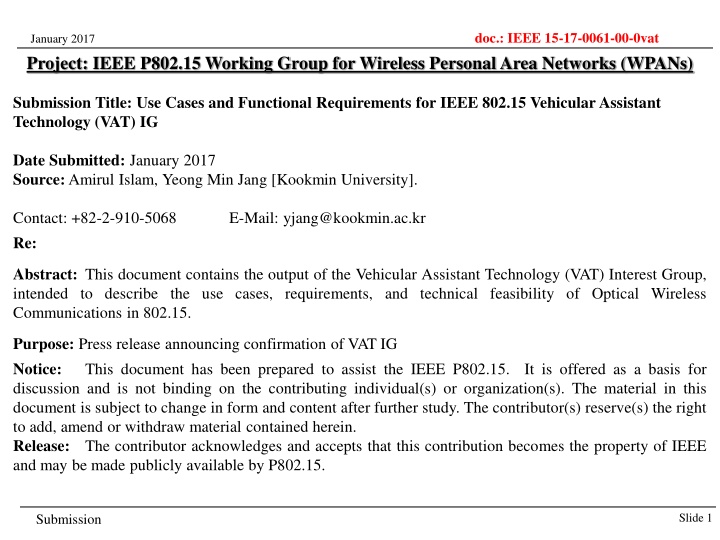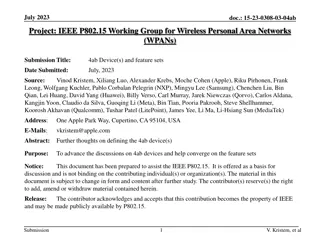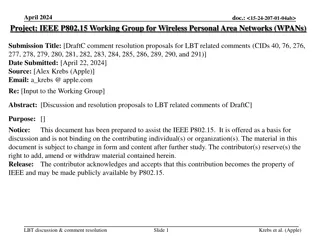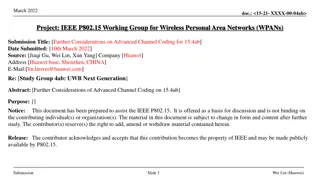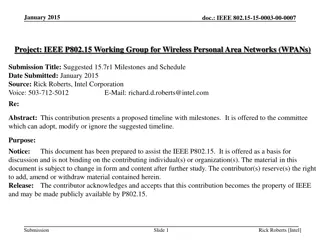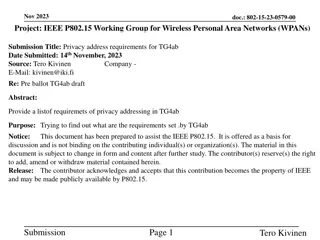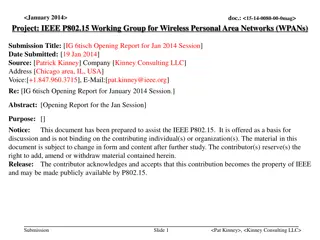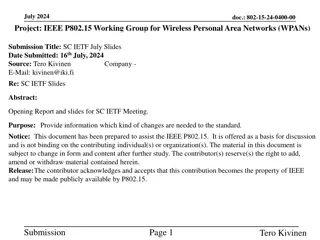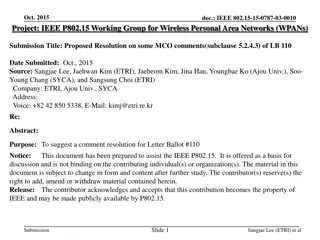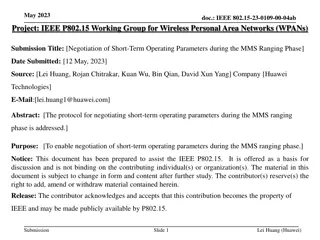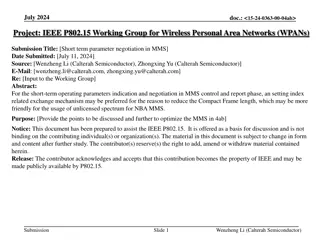Project: IEEE P802.15 Working Group for Wireless Personal Area Networks (WPANs)
This document outlines the importance of Vehicular Assistant Technology (VAT) in enhancing safety measures in automotive vehicles. It discusses the need for advanced sensor communication systems and the challenges of developing ultra-reliable autonomous vehicular systems using a combination of sensors. Various existing techniques for distance measurement are also explored.
Download Presentation

Please find below an Image/Link to download the presentation.
The content on the website is provided AS IS for your information and personal use only. It may not be sold, licensed, or shared on other websites without obtaining consent from the author.If you encounter any issues during the download, it is possible that the publisher has removed the file from their server.
You are allowed to download the files provided on this website for personal or commercial use, subject to the condition that they are used lawfully. All files are the property of their respective owners.
The content on the website is provided AS IS for your information and personal use only. It may not be sold, licensed, or shared on other websites without obtaining consent from the author.
E N D
Presentation Transcript
doc.: IEEE 15-17-0061-00-0vat January 2017 Project: IEEE P802.15 Working Group for Wireless Personal Area Networks (WPANs) Submission Title:Use Cases and Functional Requirements for IEEE 802.15 Vehicular Assistant Technology (VAT) IG Date Submitted: January 2017 Source: Amirul Islam, Yeong Min Jang [Kookmin University]. Contact: +82-2-910-5068 Re: E-Mail: yjang@kookmin.ac.kr Abstract: This document contains the output of the Vehicular Assistant Technology (VAT) Interest Group, intended to describe the use cases, requirements, and technical feasibility of Optical Wireless Communications in 802.15. Purpose: Press release announcing confirmation of VAT IG Notice: This document has been prepared to assist the IEEE P802.15. It is offered as a basis for discussion and is not binding on the contributing individual(s) or organization(s). The material in this document is subject to change in form and content after further study. The contributor(s) reserve(s) the right to add, amend or withdraw material contained herein. Release: The contributor acknowledges and accepts that this contribution becomes the property of IEEE and may be made publicly available by P802.15. Slide 1 Submission
doc.: IEEE 15-17-0061-00-0vat January 2017 Introduction (1) Now a days automotive vehicles have been considered as one of the upcoming technologies in the world. There are many researchers an d companies who are studying and trying to provide the best solutio n through their research. All over the world the number of car accident is increasing in recent days. A car accident killed more than 35,200 people last year, which has increased to 7.7% over the year to 2015. Many automotive com panies are working to improve safety with other technologies beside s unmanned vehicles. Due to the limitation of the current technologi es, it is necessary to develop an image sensor communication syste m for the vehicular environment to communicate with each other. Slide 2
doc.: IEEE 15-17-0061-00-0vat January 2017 Introduction (2) Also, there are some regulations on the use of autonomous vehicula r technology freely due to ensure human safety and trust issue on th e machine. But they are using advanced sensors to gather informati on around the world and are using sophisticated algorithms to proce ss the sensor data and control the vehicle, and need more computati onal power to run in real time. Slide 3
doc.: IEEE 15-17-0061-00-0vat January 2017 Introduction (3) Also, autonomous vehicular uses a combination of sensor, inc luding LiDAR (light detection and ranging), RADAR (radio detection and ranging), cameras, ultrasonic, and infrared. A c ombination of sensors can complement each other and prove t hem as a weak candidate for the collection of sensors data. So, it has become hardest challenges to develop an ultra-reliable a utonomous vehicular system. It is even unclear that which technology is better because of t he absence of commercially available vehicles with any fixed technology. Slide 4
doc.: IEEE 15-17-0061-00-0vat Existing techniques for distance measurement Bluetooth, Zig Bee Traditional I R based Ca mera RADAR LiDAR Ultrasonic Camera Sensor based IR based Characteri stics Efficient d istance resolution Milimetric wav e based Ultrasonic based CMOS or CCD based Laser based <10m 0.3~ 5m <200m <120m <4m <100m 3~5m 7~12cm - Used in Mi crosoft Kine ct 2-5 m 12 cm 12 cm 15-25cm - Robust at nigh t and illuminati on - Real-time dete ction - Robust at night - 3D localization - Real-time - Wide horizontal FoV - Robust at ni ght and weat her condition - Distinguish mul tiple object simult aneously - Multi-purpose - No interference - Commerciall y used in com munication are a Advantage - High cost - Hard to find s hape of object - Narrow horizo ntal and vertical FoV - Sensitive to weat her condition - High cost - Narrow vertical F oV - Short distan ce - Low resolut ion - Hard to find shape of obje ct - Sensitive to wea ther condition - Higher cost - High usage c ost - Energy consu mption when u sing Wi-Fi - Short dista nce, - Low resol ution, - Narrow Fo V Disadvant age Slide 5
doc.: IEEE 15-17-0061-00-0vat January 2017 VAT Use Cases Collision avoidance Autonomous driving and safety Distance measurement between multiple objects Avoiding drones collision Autonomous robot navigation Forward/rear collision warning Blind-spot monitoring Cross traffic alert Parking assistance Distance measurement and high-speed optical link Multi-Vehicle Speed Measurement Precise localization Slide 6
doc.: IEEE 15-17-0061-00-0vat January 2017 VAT Metrics Data rate Fast mobility support Long range Reliability and robustness Fast detection and communication Image sensor type considerations Considerations for the PHY and MAC efficiency on the capacity Slide 7
doc.: IEEE 15-17-0061-00-0vat January 2017 VAT requirements Fast processing High speed communication Detection of multiple vehicles Low-latency data delivery Compatibility with the existing systems and devices Capability support (power, directivity, wavelength, sensitivity, etc.) Slide 8
doc.: IEEE 15-17-0061-00-0vat January 2017 VAT Technical Feasibility (1) General Questions a. How does VAT work? b.How does VAT work in all lighting and environmental conditions? c. How does VAT work when you turn off the lights? d.Can we see VAT lights flicker? e. Is VAT a line of sight technology? f. Is VAT safe for human body? g.If VAT is a non-line-of-sight technology then how is it more secure than other wireless technologies? h.Will VAT work with every vehicle? i. Are VAT systems subject to multipath fading? Slide 9
doc.: IEEE 15-17-0061-00-0vat January 2017 VAT Technical Feasibility (2) System Architecture a. Compatible with existing infrastructure? b.Stand alone? Compatibility with other IEEE 802 wireless protocols Difference with on-going IEEE 802 optical wireless communication standards (e. g., 802.15.7m) Demonstrated Systems Slide 10
doc.: IEEE 15-17-0061-00-0vat January 2017 VAT Economic Feasibility Cost effective Known cost factors Consideration of installation costs Consideration of operation costs Market demands/opportunities Slide 11
doc.: IEEE 15-17-0061-00-0vat January 2017 VAT Regulatory perspective Spectrum and safety Slide 12
doc.: IEEE 15-17-0061-00-0vat January 2017 Motion to 802.15 Task Group Recommendations Slide 13
